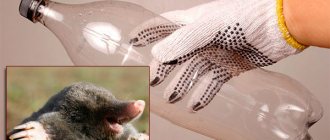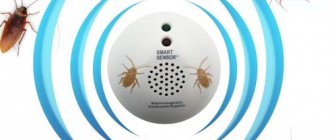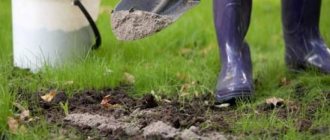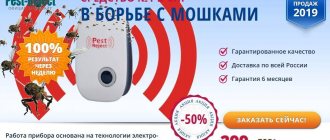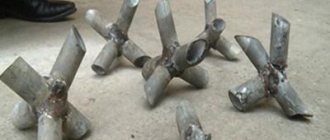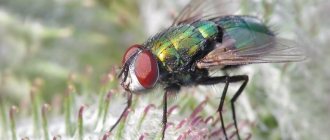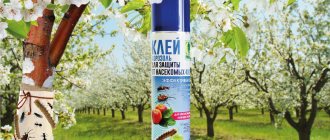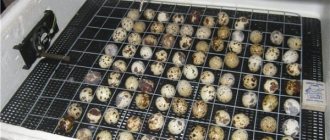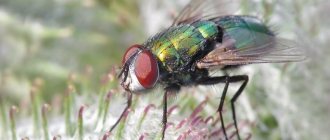14.01.2016
Wasps that appear on a suburban area cause a lot of trouble for the owners. They can start under the roof, in the attic or even in the house. These insects pose a threat of human bites, which can subsequently cause allergic reactions. In addition, wasps spoil the harvest of fruits and berries.
- Purpose of traps for wasps
- Types of wasp traps
- Types of bait in traps
- How to make your own insect trap from a bottle
- Light based wasp trap
- Advantages and disadvantages
Wasp trap
How wasps behave
Wasp and its prey.
At the beginning of the season, females, fertilized in the fall, wake up and will become queens - the builders of the house and the founders of the whole family. They begin to build the first rows of honeycombs and lay offspring.
Closer to mid-summer, a large number of aggressive, young individuals appear. They continue to build and look for food for the larvae. That's when they are the most dangerous.
Trouble from wasps
Insects eat not only assorted fruits. Wasps gnaw on fresh meat and fish. They do not disdain carrion and rot from garbage cans. Arthropod bites are dangerous and painful. Cause allergies. May be fatal. Highly organized colonies of insects cause irreparable damage to the crop. Their high intelligence is also expressed in the fact that for harm caused to one wasp, a whole swarm of wasps can fly in and attack in its defense. In addition, insects reproduce very quickly, which is especially dangerous if there are children in the family or group. These factors explain the complexity and duration of the pest control process. It will take patience and the right approach. The fight against wasps should be carried out by any available means.
How to catch a wasp
Catching a wasp with your bare hands is a completely thankless task. Not only is it almost impossible to do this, but sudden movements provoke insects into aggression.
You can catch wasps using traps. You can make them yourself.
From a plastic bottle
Bottle trap.
The easiest option is to cut a plastic bottle. You need a container of 1.5 or 2 liters. What happens next is this:
- The neck is cut off into a quarter of the bottle so that the rest is three times larger.
- The main part inside needs to be lubricated with vegetable oil so that the walls are slippery.
- The cut-off upper part is lowered into the bottle, neck down, to create a funnel-like shape.
- Bait is poured inside. It can be fermented wine, beer, a mixture of fat and meat waste.
- Set the bait and wait for the victim.
Possible modifications
Wasp trap in action.
Such traps can be made in different modifications:
- holes are made to hook elastic bands on which you can hang the trap on a tree;
- at the bottom they install elevations in order to place protein bait on it - a piece of meat or offal;
- The junction of the funnel and the bait can be wrapped with tape so that the edges do not move.
Types of traps
Wasp traps can be divided into the following 4 types:
- Plastic bottle with a flat surface. An appetizing odorous bait is placed inside.
- Device with cut holes. The same bottle, but with holes through which wasps will fly in without the ability to fly back.
- A saucer of jam, although space doesn't always work. Harmful insects may fly by.
- With funnels for pest entry.
- Technical trap (light, ultraviolet) to attract insects.
A 2.5 liter bottle can be a universal and optimal trap for hornets and wasps. It is unwise to use other types of small sizes if there are a lot of insects, climbing in swarms near the house, near cultivated plantings. In a small container, uninvited guests may simply not fit, the capture process will be incomplete.
A little about the bait
To choose a bait that will really work, you need to understand the life cycle of these insects.
in spring
The emergence of queens begins in the spring. They lay the first larvae and feed them protein. This is when food of animal origin is needed. Then fat and meat waste are used as bait.
in autumn
In the second half of summer and early autumn, wasps need a large amount of food in order to stock up on nutrients for the winter. Therefore, they are lured with sweet drinks.
What are the best baits to use?
Making a trap for wasps is half the battle. You need something to attract you. To help - baits with an appetizing aroma and a strong odor. Insects must fly and purposefully go into the trap.
It’s easy to make treats yourself from what you have on hand:
- Liquid honey (1 tbsp) per glass of water.
- Fermented fruit compote or syrup (30 ml) with the addition of 1 glass of white wine and honey.
- Light beer (0.5 l), sugar (2 tbsp. l).
- Wine vinegar (70 ml), water (0.5 l), granulated sugar or honey (2 tbsp. l).
- Jam diluted with water.
For the bait to work effectively, the smell must spread far beyond its boundaries. It is better to use a potion made from fermented products or speed up the artificial fermentation process by mixing a cocktail of jam, water, and wet yeast (1 pinch). It is recommended to place the composition not only in the trap, but also to lubricate the funnel-shaped part. The main thing is that the bait is sweet. Although in practice, mash, kvass, watermelon juice, meat, sausage, and food waste containing protein work flawlessly.
Wasps instantly flock to the beer, although the drink quickly disappears. But it is not advisable to use honey. It attracts not only wasps, but also bees.
On a note! It is not recommended to pour fresh jam or sugar syrup into the trap. Such baits are attractive to bees, but garden pollinators should not be destroyed. As bait, you can use not only spoiled or odorous products, but also poisonous purchased substances (Get, Lambda Zone, Delta Zone). Effective baits work flawlessly, are odorless, are used sparingly, and cause rapid death of insects.
How to check effectiveness
The first wasps should be trapped within a few days. Then it will be clear that it works well. If the bottle remains empty, you need to change the location or filling.
If the bottle is full, you need to carefully empty it. It is just very important that all the insects inside are dead, otherwise they will be very aggressive. Moreover, they will pass on information about the danger to others.
Corpses need to be disposed of properly - they release a substance that attracts others. Therefore, they need to be buried or drained into the sewer.
What to do if wasp traps don't help?
In exceptional cases, even with the constant capture of a large number of wasps, their number in the area may not seem to decrease. In such situations, you either just have to wait until the grapes or raspberries go away, or find their nest in the vicinity and destroy it.
In high-density gardening communities, wasps will almost certainly take up residence on someone's property. By going around your neighbors, you can eventually find the “lucky one” who has their nest, or often several at once, hanging in his attic or closet. In addition, in apiaries or in the vicinity of abandoned areas, you can catch a couple of wasps with leather gloves, tie scarlet ribbons around their abdomen, release them and watch where they fly. In just half an hour you can find their nest.
Sources
- https://7ogorod.ru/prochee/lovuska-dla-os-iz-plastikovoj-butylki.html
- https://SdelaySam-SvoimiRukami.ru/5231-kak-sdelat-jeffektivnuju-lovushku-dlja-os-iz-plastikovoj-butylki.html
- https://GdeKlop.ru/osy-i-pchely/samodelnyi-lovushki/
- https://MrKlop.ru/zhalyashhie/osy/kak-sdelat-lovushku-dlya-os.html
- https://bezbukashek.ru/sredstva/lovushki-dlya-borby-s-osami
- https://beetlestop.ru/lovushki-dlya-os/
- https://klopkan.ru/osy/delaem-lovushku-dlya-os/
- https://7ogorod.ru/prochee/lovuska-dla-os.html
- https://apest.ru/osy/kak-izbavitsya-ot-os/lovushki-dlya-os/
- https://klop911.ru/shershni-i-osy/osy/lovushka-dlya-os.html
[collapse]
Safety precautions
Hanging trap.
It must be remembered that it is better to avoid all contact with wasps. They, especially when they feel threatened, become aggressive. If there are any living individuals left, you will need to wait or shake the bottle a little so that everyone is in the water. Carry out cleaning in a timely manner!
Safety precautions must be followed:
- Place traps in a secluded place.
- Unload only dead insects.
- Make sure no bees get in there.
- Do not use toxic substances.
Pros and cons of homemade traps
Devices in the fight against wasps compare favorably with their analogues, because:
- environmentally friendly than other chemical insecticides;
- safe with a simple structure and no use of toxic substances or poisons as bait;
- universal, because can be installed anywhere: garden, room;
- accessible due to the possibility of self-production at minimal cost;
- easy to use;
- do not have a negative impact on bees;
- multifunctional, because once you have made a trap you can use it repeatedly for wasps, flies, moths, and mosquitoes.
A wasp trap is a temporary distraction and will not be able to completely and permanently protect your home or cottage from hordes of insects. This is a minus.
You will also need to periodically check the container, clean it from pests, and dispose of them. It is equally important to prepare an attractive bait and replace it as insects eat it.
A situation where wasps have settled on the site or are attracted to something
This is exactly my case, which I have written about several times (for example, here).
Let me remind you that we have several sweet pears that we cannot pick due to the height of the trees. And the wasps took a liking to them, especially those fruits that fell to the ground (and a lot of them fell!)
Those. The situation is such that the wasps had sort of set up a home for themselves (a nest - more on that below), but regularly and in large numbers flew to our site.
Moreover, when one pear was left without fruit, there were no wasps around it either - they all flew to the next “victim”.
Since this is only the first year of such an invasion, I made traps from PET bottles, as I wrote about above.
Yes, wasps were caught, but I did not observe a significant decrease in them.
Therefore, the way out of this situation is to eliminate the source that attracts them. For example, cutting down most of a tree, leaving only a few easily accessible branches.
But there is another scenario for the development of events - the wasps have built a nest somewhere on your site or, even worse, in a hard-to-reach place (for example, behind the casing).
How to get rid of wasps - action plan
- First you need to find the wasp's nest. If you can’t do this visually, you can catch the “victim,” attach an “identification” sign to it and track where it flies. You can, as an option, lay out the fish with the “smell” and observe where the wasps carry their prey
- Destruction of wasps without destroying the nest is money, as they say, down the drain. If the nest is easily accessible, you can submerge it in a pan or bucket of water for a few minutes. Or put a bag on the wasp nest, secure it (with tape), cut off the corner of the bag and spray insecticide in a spray - after a few minutes, tear off the bag along with the nest and destroy it. If the nest is small, you can direct the spray from the can directly at it. Just get dressed before doing this and do it in the evening or at night, when all the wasps are lethargic and all are hibernating in the nest. You can “suck up” the wasps with a vacuum cleaner, and then spray some kind of insecticide into it. If wasps are in the ground, you can pour boiling water over their nest. It is not always effective from a saucepan or kettle, because... there's not enough boiling water there. If you have a summer water supply and the water in it on a sunny and hot day approaches boiling water, then you can fill these nests with a hose with your soul. After this, it is best to fill the nest (it looks like a molehill) with earth and compact it. Here are other suitable preparations: “Troapsil”
(Trapsiel, the Netherlands) is a professional remedy for household insects. - Aerosol "Moskitol Protection against Wasps"
- designed for the effective and long-term destruction of wasp nests and wasps on the street and in non-residential premises (barns, attics, open verandas). - You can carefully treat
the nest itself and especially the entrance to it with Gett Wasps, crawling into a nest, will definitely bring microcapsules of the drug there, which will kill both themselves and the entire population of insects. If the nest itself is not accessible, but you notice where the wasps are crawling, for example, under the roof, then treat this place generously, the effect will be the same. The wasps will die in a day or two. - “Smelnet”
(Smell-no: Netherlands) is a microencapsulated insect repellent, odorless. It is intended for the independent destruction of blood-sucking and synanthropic insects: mosquitoes, bedbugs, fleas, cockroaches, ticks, flies, wasps, ants, etc. This is an odorless, microencapsulated drug with a long-lasting effect of up to 8 months. - Dichlorvos, Super-Cobra
(spray against flying insects), but there is a danger of being bitten by half-drunk wasps. Then, if you decide, put on very thick clothes, gloves, etc. to fill the nest, remove it and destroy it completely.
An important tip - after removing the nest, to prevent wasps from starting there again, clean the place where the nest is attached with sandpaper or a knife and ALWAYS wipe it with some kind of antiseptic - a solution of potassium permanganate or hydrogen peroxide.
How to catch hornets correctly
To be more effective, you need to make several traps and place them throughout the site, preferably away from paths where people walk. As the insects accumulate, the devices are replaced with new designs. If you don’t want to make other traps, you can empty these ones without neglecting safety measures. First, it is recommended to spray any insecticidal agent inside the bottle or jar. After the hornets die, you can open the trap and shake out the contents.
The manufactured structures can be hung on trees. To do this, you need to make holes in the bottles and insert a string or rope there. If after some time only a few insects have been caught in the trap, it should be moved to another place.
Trap in a jar
Important! If there are a large number of insects on the site, it is best to take large containers to make traps. In this case, it will not be necessary to change and empty the structures too often.
Purchased products: types, prices and reviews
If you don’t want to bother making a wasp trap yourself, then you can easily buy one. For example, the following models are actively sold in agricultural stores or online today:
- Wasp Trap is a wide plastic trap with a clear top and colored bottom. It has special entrances directed inward and upward, and the wasps that are inside can no longer find these entrances. The Wasp Trap has a convenient mount for hanging on branches, and costs about 400 rubles.
- Swissinno, Swiss made trap. Works much the same as the Wasp Trap, but looks like a neat little bucket. Sold already with bait that does not attract bees. It also costs about 400 rubles.
- GUARD'n CARE, made in China by order of a Dutch concern, is a product with several compartments of different widths. Costs about 350 rubles.
All of these traps are quite effective, and the price does not reflect their quality. You can buy either the one that is cheaper and easier to deliver, or the one that is in stock (we recommend giving preference to the Swissinno trap).
Review
“We suffered from wasps this summer. They made a nest in the fence at the dacha, and my daughter and I arrived a day before my husband. Well, on the very first day we were bitten once. I called my husband, he arrived with a purchased trap. This is a bucket with holes on the sides. They hung it right next to the nest and poured sweet compote into it. The wasps were caught for several days until the entire trap was filled, but this was not much use. The rest were flying anyway. It ended with my husband dousing their nest with gasoline at night and burning it.”
Yana, Kirov
It’s also useful to read: How you can get rid of wasps in your house and exterminate them in your summer cottage
Safety precautions when using traps
So, the hornet or wasp has already been caught, but, nevertheless, they remain dangerous until their death. Contact with the trap without fear of being stung is only possible if the insects are dead. If the wasps or hornets are still crawling, it is enough to spray them with any means for removing cockroaches, and only then, after making sure that the insects have died, begin emptying the trap.
Extreme care must be taken when placing and checking traps located in close proximity to insect nests. Here, hornets can attack if they think a person is threatening their nest. That is why you should not place the trap closer than 20 m to the insects’ home, because At this distance, wasps can easily smell the bait, but will not attack the person placing it.
“We have a neighbor who was into such things with hornets. I put bottles and some buckets. Once a hornet struck him in the neck, and the ambulance barely managed to take him to intensive care. The wife could not stand it and called the Ministry of Emergency Situations. The guys arrived, with jokes and jokes, they demolished all the rubbish in the attic in his barn, put the nest from under the roof into a bucket and filled it with bleach. So they took me out.”
Other manufacturing methods
The trap is made differently. It is made from 2 plastic bottles. A cross-shaped cut is made in the body of one of the containers, into which the conical part from the second bottle is inserted with the neck. A wasp trapped through a funnel-shaped entrance is unable to get out.
The cover on top of this structure must be screwed on. After removing it, you can pour bait into the container. The trap can be equipped with 2 tap holes. In this case, the smell of the bait will spread more intensely. Side funnel traps use sweetened compounds to attract wasps.
If there are few wasps in the area, you can make a simple trap by drilling several holes with a cross-section of no more than 8 mm in a closed plastic bottle. In most cases, insects that get inside cannot get out. Of course, the effectiveness of the trap needs to be increased by adding poisoned bait to it.
Advantages of homemade airplanes
The positive aspects of the devices include:
- low cost: practically all traps are made from materials at hand or prepared for disposal;
- environmental friendliness: the mechanical method does not involve the use of poisons and chemicals;
- large coverage area: manufactured catchers are hung in the required quantity without limitation;
- mobility: can be hung, placed anywhere, placed indoors or outdoors;
- non-volatile: does not require connection to the network or use of batteries;
- ease of maintenance: it is enough to periodically dispose of caught insects and update the bait;
- unlimited field of activity: you can always experiment and implement the most unexpected ideas.
Traps are justified in cases where the nest cannot be detected. It is impossible to catch all the wasps with them, but it is quite possible to “deflect the blow” from a house or dacha. And most importantly, everyone can make a simple and effective product. There would be a desire.
Source
How to attract hornets and wasps
Wasps and hornets can be attracted by a large number of foods from fruits to spoiled fish. Practice shows that the most attractive baits for them are:
- a mixture of beer with honey or simply sweetened beer
- strong-smelling syrup
- fermented raspberries or grapes
- fish.
Of course, in each specific case you need to use exactly the bait that will not disturb the atmosphere of the place. For example, even those wasps that would never visit the area will flock to fish with a scent, but for a person it is not very pleasant to be near such bait.
